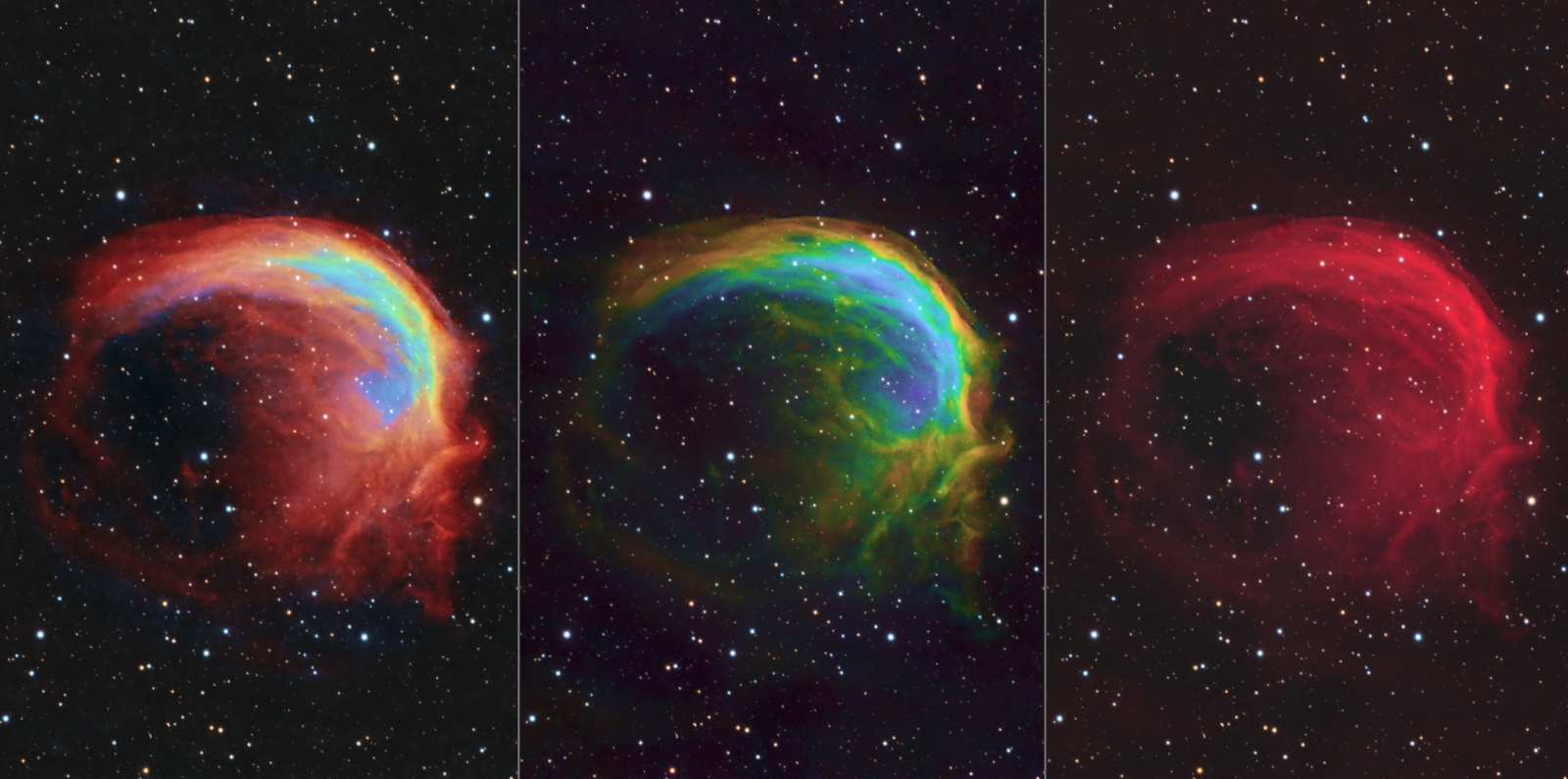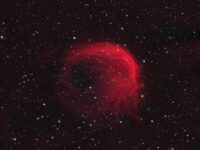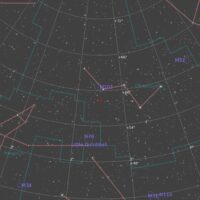Sh2-188
Click images below for full resolution versions
October 5, 2023
Sh2-188, sometimes called the Dolphin Nebula, the Shrimp Nebula or the Prawn Nebula is a faint planetary nebula. It lies in Cassiopeia a little more than 700 light years away. It is estimated to be around 7,500 years old. Although it is circular, it has uneven brightness. The star that is energizing the nebula is moving rapidly in the direction of the brightest region. Although hydrogen dominates the visible emissions (see the very red natural colour image at right), oxygen and sulphur also contribute, as shown in the narrowband versions (Forrax Palette at left and Hubble Palette, centre).
Tekkies:
Acquisition, focusing, and control of Paramount MX mount with N.I.N.A., TheSkyX and PHD2. Primalucelab low=profile 2″ Essato focuser and ARCO rotator. Equipment control with PrimaLuce Labs Eagle 4 Pro computer. All pre-processing and processing in PixInsight. Acquired from my SkyShed in Guelph. Average transparency and seeing. Data acquired under moderate moonlight between September 22 – October 3, 2023.
Celestron 14″ EDGE HD telescope at f/11 (3,912 mm focal length) and QHY600M camera binned 2×2 with Optolong filters.
10x5m Red = 0hr50m
8x5m Green = 0hr40m
8x5m Blue = 0hr40m
124x5m Ha = 10hr20m
59x5m O3 = 4hr55m
59x5m S2 = 4hr55m
Total: 22hr20m
Preprocessing: The WeightedBatchPreProcessing script was used to perform calibration, cosmetic correction, weighting, registration, local normalization and integration of all frames. DrizzleIntegration was included for the narrowband filters (Gaussian, 1x, drop shrink=0.9).
Colour master: A colour master was made from the Red, Green and Blue masters using ChannelCombination in RGB mode.
Gradient Removal: DynamicBackgroundExtraction was applied to the RGB and narrowband masters.
Colour Calibration: ColorCalibration was used to calibrate the RGB master.
Deconvolution: BlurXterminator was used on the RGB and narrowband masters with Automatic psf , and star sharpening set to 0.10 with “Correct First” selected.
Linear Noise Reduction: NoiseXterminator was applied to the RGB and narrowband masters with settings Amount=0.9 and Detail=0.35
Star Removal: StarXterminator was used to remove the stars from each of the RGB and narrowband masters, with default settings. Only the RGB stars-only image was preserved.
Stretching: HistogramTransformation was applied to the RGB and narrowband masters to make pleasing images. Approximate background level after stretch was 0.10 for RGB and 0.08 for the narrowband masters.
Nonlinear Processing
HaRGB Image Creation: PixelMath was used to blend Ha into the RGB image using the following expression with parameter values a=1.2 and b=0.06.
Red: max($T[0], a*Ha)
Green: $T[1]
Blue: iif($T[0]<a*Ha, $T[2] + b * Ha, $T[2])
Hubble Palette Image Creation: The S, H and O masters were combined using ChannelCombination in RGB mode.
Foraxx Palette Image Creation: The S, H and O masters were combined with Paul Hancock’s Foraxx Palette Utility script.
Nonlinear Noise Reduction: NoiseXterminator was used to reduce noise in the background areas of the HaRGB, SHO and Forrax images with settings Amount=0.9 and Detail=0.2
Contrast Enhancement: LocalHistogramEqualization was applied three times to each image. A Contrast Limit of 1.5 and 1 iteration was used for each LHE application (scale 20, strength 0.35; scale 90, strength 0.25; scale 150, strength 0.15).
Sharpening: A mask was used to select brighter regions of nebulosity in each image for sharpening with MultiscaleMedianTransform (Layers 1 – 5 with strengths of 0.03, 0.05, 0.08, 0.06, and 0.03, respectively).
Brightness Enhancement: Using a mask to protect the background, the nebula was brightened in each images with ExponentialTransformation and CurvesTransformation.
Stars-only steps: MorphologicalTransformation was used in Morphological Selection mode to shrink the stars through a mask made by extracting the Luminance from the stars-only image. CurvesTransformation was used to add saturation to the stars.
Hubble Palette and Foraxx Colour Adjustments: CurvesTransformation was used with the Hue tool to adjust the colour tones in the two narrowband images.
Star Restoration: PixelMath expression combine(starless, stars, op_screen()) was used to combine the three starless images with the RGB stars-only images created with StarXterminator.
Final Steps: Background, nebula and star brightness, contrast and saturation were adjusted in several iterations using CurvesTransformation with masks as required. ICCProfileTransformation (sRGB IEC61966-2.1; Relative Colorimetric with black point compensation) was applied prior to saving as a jpg. The finder chart was made using the FindingChart process.











Nice image, Ron.
Those faint galaxies interest me too. I recently shot NGC7599. Apart from the other obvious Galaxies in the field (7590, 7582) there were, on close inspection of a large print I made, about 20 others!
Regards,
Mark
Excellent